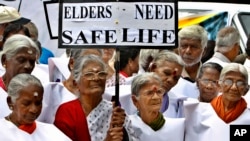Women around the world are living longer, are better educated and are marrying later than has been the case over the past 20 years, but millions remain illiterate and many have been victims of domestic violence, a U.N. report issued Tuesday said.
Men outnumber women by 62 million, a result of enduring natural selection processes. But by old age, those differences disappear as women represent 54 percent of the population over age 60. Globally, life expectancy has risen over the last 20 years, with women living to an average of 72 in 2015, up from 64 in 1995.
Women, in general, are marrying later, at an average age of 25. That's a reflection, the report said, of increased education levels, greater economic independence and a rise in informal unions.
The report said that although the rate of child marriage has declined, more than one in four women ages 20 to 24 are married before age 18. Those numbers are higher in southern Asia and sub-Saharan Africa.
Women also are having fewer children. "Globally, the total fertility rate reached 2.5 children per woman in 2010-2015, a decline from three children in 1990-1995," according to the U.N. study.
Women in Europe have the fewest number of children, fewer than 1.6 children per woman, with an even lower rate of 1.3 in Eastern and Southern Europe. In developing regions, however, the average number of children reached 2.7 per woman. The highest fertility rates averaged 5.6 in Central and West Africa.
One-parent households are increasingly becoming common in both developed and nondeveloped countries, according to the study, with three out of four of those households being single mothers with children.
The U.N. said most are attributed to divorce and extramarital fertility. The report added that households headed by women without a partner are more likely to be poor than similar households headed by men.
Education
Although the enrollment of girls in secondary school has increased, it remains lower than enrollment in primary school. The number of women attending colleges and universities has increased globally, surpassing male participation in almost all developed countries and half of developing ones.
The report said the vast majority of young men and women have literacy skills, but that an estimated 781 million people over age 15 remain illiterate. Two-thirds of them are women.
According to the U.N., as of 2015, only half of women of working age are in the labor force, compared with three-quarters of men. The regions with the fewest women in the labor force are Northern Africa, Western Asia and Southern Asia.
The majority of women are employed as domestic workers in both developing countries (73 percent) and developed regions (83 percent). For every dollar earned by a man, women earn between 70 and 90 cents.
The report added that women generally spend three additional hours a day doing unpaid work, such as household chores, in developing countries and two hours more than men in developed ones.
Violence
"Women across the world are subjected to physical, sexual, psychological and economic violence, regardless of their income, age or education," according to the U.N. study.
An average of one in three women has experienced physical or sexual violence, while around the world two out of three partner- or family-related homicide victims are women.
At least 119 countries have passed laws on domestic violence, 125 have laws on sexual harassment and 52 have laws on marital rape.
The U.N. report said, however, that in the majority of countries, less than 40 percent of victims will seek any sort of help. Those who do look for help speak to family or friends, instead of police or social services.
The report said attitudes toward domestic violence are starting to change in almost all countries where information on the problem are available.












